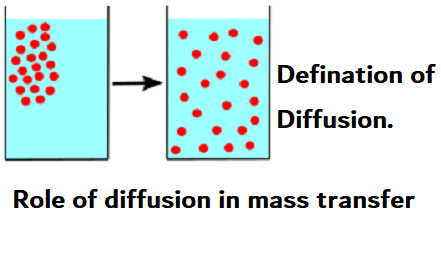Distillation ( Diffusion mass transfer) Diffusion definition in Hindi: किसी component के मिश्रा में मैं नियत ताप ब दाब पर किसी external force की सहायता से या बिना किसी help से high concentration region से low concentration region मे flow ko diffusion कहलाता है.
Diffusion ka important कारण diffusion component ka concentration gradient की पर्बेरति component की concentration equalize करने की ओर gradient ko नअष्ट् करने की होती है, diffusion ka म्युखये कारण concentration gradient hota है फिर भी diffusion activity gradient के कारण होता है.
Type of diffusion
Molecular diffusion
When diffusion results from the random movement motion of the molecules is called molecular diffusion.
Turbulent diffusion
When the movement of the molecules occurs with the help of an external force is called eddy Or turbulent diffusion.
Note- Molecular diffusion is a slow process whereas eddy diffusion is a fast process.
Role of diffusion
Diffusion may occur in one phase or in both phases in all the mass transfer operations. In the case of distillation, the more volatile component diffusion through the liquid phase to the interface between the phases and away from the interface into the vapour phase. The less volatile component diffuses in opposite directions and passes from the vapour phase to the liquid phase.
In the case of gas absorption, the solute gas diffuses through the gas phase to the interface and then through the liquid phase from the interface between the phases. In the case of crystallization, the solid solute diffuses through the mother liquor to the crystals and deposits on the solid surface. In the case of drying operation and diffuses as a vapour into the gas phases. In the case of liquid-liquid extraction, the liquid solute diffuses through the raffinate phase and then into the extract phase from the interface between the phases.
Molecular diffusion
Concentration, Velocities and Fluxes:
Concentration: There are various ways to express the concentration of the various species in a multi-component system mixture we limit our discussion to the mass concentration, molar Concentration and mass concentration and function.
Mass concentration: It is the mass of species per unit volume of the solution (mixture). It is equivalent to the density of A anodizing noted as Pa.
Molecular diffusion equations
For the above binary system compass of A and B
Pa + Pb = ρ Where ρ is the mass density of the solution.
Molar Concentration: It is the number of moles of species A per unit volume of the solution.
CA = ρA/MA
Where MA is the molecular weight of component of A the unit of a molar. The concentration in the S.I. unit is Kmol/m3. Hence for a binary system of A and B, the total molar concentration mixture is given by
C = CA + CB
Mass Fraction: The mass fraction XA of species A may be defined as the ratio of the mass concentration of species A to the mass density of the solution.
XA = ρA/ρ
Mole Fraction: The Mole fraction of A can be defined as the ratio of the molar concentration of A to the molar concentration of the solution.
XA = CA/C
Velocities
In a diffusion mixture, various chemical species are moving at different velocities as they may have different mobilities. the bulk velocity of the mixture would be some sort of an average velocity. Let Ui be the velocity of the iTH species concerning the stationary coordinate system. Then for a mixture of n species the local mass average velocity U is defined by
Pu is the local rate at which mass passes through a unit cross-section when it is placed perpendicular to U. In a binary system of A and B components.
Mass velocity formula U = PAuA+PBuB/ P
Mass flow rate: It is the quantity of material flow in mass units per unit of time.
Molar flow rate: It is the quantity of material flow in molar units per unit of time.
Flux definition in mass transfer
The mass transfer flux of a given species is defined as the amount of that species in either mass or molar units that crosses a unit area per unit of time. We will define four types of fluxes two concerning fixed coordinates in space and two concerning local mass average velocity and local molar average velocity(w.r.t. coordinates moving with mass average velocity and molar average velocity).
Mass Flux: The mass flux of a species i is defined as the mass of the species i that passes through a unit area per unit of time. The mass flux relative to the stationary/fixed coordinates is given by,
Mass flux Formula , ni = ρi ui
The mass flux relative to the mass average velocity u is given by,
ji = ρi (ui - u)
Molar Flux: It is defined as the moles of species i that pass through a unit area per unit of time. The molar flux relative to the stationary coordinates is given by,
Molar flux Formula , Ni = Ci ui
The molar flux relative to the molar average velocity U is given by,
Ji = Ci (ui - U)
Any one of the above-mentioned notations used for the flux is indeed adequate for all diffusion problems, but each has certain advantages. In process calculations, it is usually desirable to refer to a coordinate system fixed in equipment so the flux Ni is used in engineering.
>Fick's law diffusion | Film theory mass transfer
>Counter current and co-current mass transfer
Take these Notes is, Orginal Sources: Unit Operations-II, KA Gavhane


